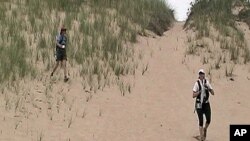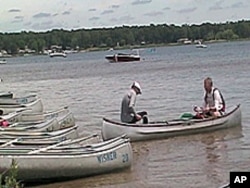If you're looking for an endurance race to compete in, there are plenty of choices out there: marathons, biathlons, triathlons.
And then there's adventure racing.
This multidisciplinary team sport sends competitors out with a map and a goal, relying on their own strength and abilities to traverse great and challenging terrain for several hours or a few days.
Hundreds of local adventure races take place all over the globe every year.
Pam Riehl Szakal and Sue Segel are participating in Stark Raving Mad, a six-hour event near Lake Michigan. This is their first adventure race together.
Pam, a life-long outdoorswoman, is a ten-year veteran of the sport, while Sue, a self-described physical fitness enthusiast, is competing in just her second race. "You have no idea what you're going to be up against," she says. "That's what I think makes it exciting."
Strategy and surprises
Adventure Racing began in New Zealand with core events in cycling, paddling, and trekking, any sort of on-foot segment. However, it quickly spread to become a worldwide sport with local clubs springing up from Germany to Jamaica.
Race directors often add surprises such as mountain climbing, white water swimming, or horseback riding to the challenge.
Pam says expecting the unexpected is part of the appeal of the event. "It's really about what I would call almost the intellectual side of it, which is the strategy," she explains. "You've got to think. Unlike a triathlon - where it's just do, do, do and you know exactly what you're going to do - every adventure race is different."
But the key element of every adventure race is orienteering, navigating by map and compass.
So, as Stark Raving Mad Director Scott Campau explains, there is no preset course. "Racers are given maps with checkpoints on them and racers have to navigate themselves using a compass and their own sense of direction to these different check points." In fact, courses are kept secret and revealed only minutes before the beginning of an event.
Off and running, and biking, and…
Pam and Sue, who call themselves Team Two Non-Blondes, take their place at the starting area alongside teams with names like Lost in the Woods, Hemorrhoids, and Comfortably Numb.
While teams can physically prepare, Pam says mental preparation is difficult. "Sometimes you try to strategize ahead and think, 'Oh, I can figure this out, there's only this piece of water and this,' and you find out you're completely wrong," she says with a laugh. "So it's all about trying figure out the best way to take the course and how you can get the best strategy out of what they've given you."
The first leg of Stark Raving Mad begins with a short run through the woods. But there's a twist. Teams must carry all their biking gear with them and stay within 91 meters of each other or face disqualification.
Sue says this is where she relies on Pam. "You can work off of each other, like Pam is more of a runner, I'm more of a cyclist, so hopefully we would help each other out."
Next the teams quickly hop on their bikes for a several kilometer long off-road trek.
Team chemistry
While a few races allow soloists, adventure racing is primarily a team sport. Teams can be made up of anywhere from 2 to 15 people depending on the race.
Pam says finding the right chemistry among members is vital. "I've watched teams fall apart because they don't get along and I've seen other teams very successful because they just click together."
In the third leg, participants trade their bikes for canoes and head out on the water for a 15-kilometer long paddle against the wind. Then it's time for a hike through mountainous sand dunes.
All along the route are check points. Racers carry passports, which they punch at each station to prove they were there, and gain one point.
Unlike most competition, where the fastest time wins, in adventure racing, the team with the most points before the cutoff time is the winner.
Unfortunately, Sue lost Two Non-Blondes' clear plastic passport on the trek through the sand dunes. Though this disqualified them, they continued the race for fun.
Finishing with flair
As the racers orienteer their way to the finish line, race director Scott Campau has one last surprise for them. "We're really happy to be able to utilize the only wheeled luge track in North America. It just opened up at Muskeegon Winter Sports Complex."
Participants are given a quick course in roller luging - which is like the more familiar Winter Olympic sport, except on wheels. Then they whisk down the hundred plus meter long tube, slamming into two large airbags for a grand finish, and bragging rights for the winners.
"You're not going to make money on it," Campau admits, "but it's not about the prizes. It's just about you going out there and challenging yourself."
Though the Two Non-Blondes couldn't officially finish, they did unofficially come in with the best time and most points for a female team. Sue says she can't wait to take on an even longer race. But next time, she insists, Pam will be in charge of the passport.















